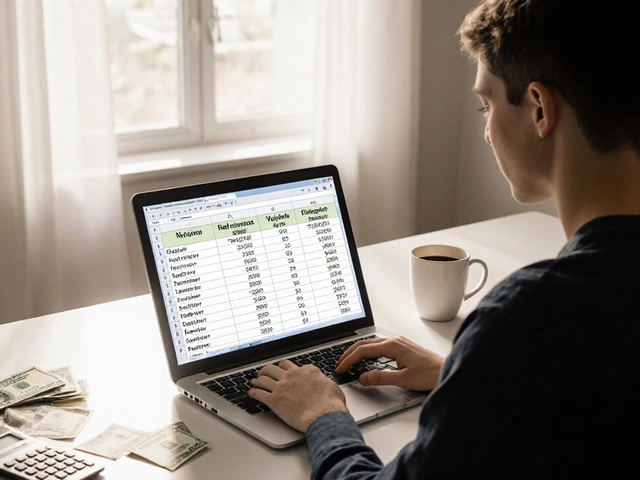
If you’re wondering what kind of APR a 700 credit score gets you on a personal loan, you’re not alone. Most people hit 700, feel pretty good, and expect banks to roll out the red carpet. The reality? Lenders like that number, but it doesn’t just unlock ultra-low rates automatically.
Right now, in June 2025, a 700 credit score puts you in a strong spot—think above average, but not VIP lounge. You’ll likely see personal loan APRs anywhere from around 7% to 18%, though outliers exist. That’s a wide range, but lenders have reasons. They check more than your score. Income, how stable your job is, your existing debts, and even the size and purpose of the loan all play into the mix. Ever wonder why your buddy with the same credit score snagged a 9% rate, but you got a quote for 15%? That’s why.
Here's something people rarely say out loud: APRs are negotiable, especially if you shop around or if you’ve been offered a better deal elsewhere. Collect offers from a few lenders. Use one offer to nudge another bank down a notch—sometimes all it takes is proof in your inbox.
- What Is APR and Why Should You Care?
- How Lenders View a 700 Credit Score
- Typical APR Ranges for 700 Credit Scores
- Other Factors That Change Your Rate
- How to Get the Best Possible APR
- What to Watch Out for Before Signing
What Is APR and Why Should You Care?
APR means Annual Percentage Rate. It tells you the total yearly cost of borrowing money, not just the interest, but also some fees worked in. When comparing personal loans, looking at APR gives you the real cost, so you’re not caught off guard by sneaky extra charges.
Here’s the thing: even if two loans offer the same interest rate, one could have a higher APR because of origination fees or mandatory insurance. This is why focusing only on interest rate doesn’t always get you the best deal. As the Consumer Financial Protection Bureau puts it:
“The APR lets you compare loans with different interest rates and fees, so you know which costs more overall.”
Say you have a 700 credit score and snag a loan. Depending on the lender, your APR will usually reflect not just your credit profile but the loan term, amount, and other factors.
Check out this quick breakdown of how APR shapes your total borrowing costs:
| Loan Amount | APR | 3-Year Total Interest Paid |
|---|---|---|
| $10,000 | 8% | $1,282 |
| $10,000 | 14% | $2,244 |
| $10,000 | 18% | $2,956 |
See the difference? Even a few percentage points can cost you hundreds or even thousands. Never ignore APR when shopping for a loan.
Here’s a quick cheat sheet on why APR matters:
- It reflects the true yearly cost of your loan.
- You can easily compare different loan offers using it.
- Lower APR usually means less money paid over time.
How Lenders View a 700 Credit Score
When a lender looks at a 700 credit score, they see you as responsible but not at the very top of the heap. In the world of lending, 700 usually falls into the “good” category—even though the average U.S. FICO score hovers around 715 as of late 2024. This means you’re ahead of a lot of folks, but you’re not quite elite.
Here’s what’s actually going on behind the scenes: lenders use risk-based pricing. Your 700 score puts you in a range where you’ll qualify for most personal loans and probably won’t get hit with outrageous interest, but you probably won’t see the lowest advertised rates plastered in big letters either. Those eye-popping 6% or lower offers? They’re mostly reserved for people pushing 760 and above with squeaky-clean reports.
But don’t stress—700 is still considered strong. Lenders like it because people in your range tend to pay back what they owe. They see a lower chance of you defaulting. Some banks even have their own internal cutoffs, and a 700 is often the line where fees drop or approval is much more likely. Still, every lender plays by its own rules.
Take a look at this table showing where a 700 score sits compared to other ranges and the kind of rates you might see:
| Credit Score Range | How Lenders Rate It | Typical Personal Loan APR Range |
|---|---|---|
| 760+ | Excellent | 6% - 10% |
| 700-759 | Good | 7% - 18% |
| 660-699 | Fair | 13% - 23% |
| 600-659 | Poor | 17% - 31%+ |
Banks also check more than just your score. They look over your income, debt-to-income ratio, how steady your job is, and whether you’ve had late payments or collections in the past two years. Some even glance at why you want the loan. If you’re consolidating debt, that might even boost your chances versus if the cash is for a risky new business idea. Don’t just focus on the number—think about your whole financial picture.
Typical APR Ranges for 700 Credit Scores
If you’ve got a 700 credit score and you’re shopping for a personal loan, here’s what the numbers look like right now. With most national lenders, your APR will usually fall between 7% and 18%. Some online lenders might creep a little higher but push below that only happens if you’ve got an even better profile or maybe a special relationship with your credit union.
Check out this table to see where different lenders typically land for folks with a 700 credit score:
| Lender Type | Typical APR Range (June 2025) | Notes |
|---|---|---|
| Traditional Banks | 9% - 16% | Prefer longer credit history and stable income |
| Credit Unions | 7% - 14% | Often the lowest rates, but membership required |
| Online Lenders | 10% - 18% | Quick approval, but sometimes higher rates |
Don’t expect to hit the very bottom of these ranges just because your score says 700. Lenders love to layer on details—how much you’re borrowing, your monthly outgoing payments, even if you’re self-employed. And if you see a rate offer under 8%, that’s just about as good as it gets for a 700 these days.
One little tip: promotions sometimes pop up, especially at local credit unions or smaller banks. You might see a random offer in the mail or email for a temporary rate drop, like "1% off if you set up auto-pay." These are worth checking out because every percent counts on a multi-year personal loan.

Other Factors That Change Your Rate
So you've got a 700 credit score—nice. But there's a lot more behind the APR you get offered on a personal loan. Lenders dig deeper than just your score. Here’s what can really move the needle:
Income and Employment Stability: Lenders love reliability. If you’ve been at the same job for a while or have a steady paycheck, you’ll seem less risky, and you could snag a lower rate. Jumping between gigs or being self-employed can make lenders nervous, and they might bump your APR.
Debt-to-Income Ratio (DTI): This measures how much of your monthly income is already spoken for by debts. If you’re already juggling a car loan, credit card balances, and a mortgage, even with a solid credit score, lenders might offer you a higher APR. Most want your DTI under 40% for the best rates.
Loan Amount and Term: Planning to borrow a bigger chunk of cash or stretch payments over more years? Expect that to cost you. Lenders often see longer terms or higher amounts as riskier, so the APR goes up. Smaller loans or shorter terms can sometimes score you a lower rate.
Purpose of the Loan: Believe it or not, what you plan to do with the money can make a difference. Consolidating high-interest credit cards usually gets better terms than borrowing for a vacation. Lenders ask for a reason and factor that into the risk profile.
The Lender Itself: Online-only lenders, big banks, and credit unions all play by their own rules. Credit unions, for example, often run on a not-for-profit model, so they sometimes drop rates a bit compared to banks. Online lenders might approve you faster but sometimes charge a little more for that speed and convenience.
- Got a co-signer? That could help chop your APR, especially if they have great credit and stable income.
- Opt for autopay: Some lenders knock 0.25% to 0.5% off your rate if you set up automatic payments.
- Your credit history length counts too. If you’re just starting out, even with a 700 score, you might get higher rates than someone with years of spotless payments behind them.
Bottom line: when you’re comparing APR offers, make sure you’re matching apples to apples. Small things on your application can swing your rate by a few points. Double-check what’s helping or hurting you before you commit.
How to Get the Best Possible APR
Scoring a great APR isn’t about just flashing your 700 credit score and calling it a day. Lenders want to see you’re low-risk across the board. Here’s how to actually lock in that bottom-barrel rate on your next personal loan.
- Check your credit report before applying. Sometimes bad info slips through. One wrong account or late payment drags down your actual borrowing power. Fix errors, even if they seem small—the impact on your APR can be bigger than you think.
- Shop around. Don’t take the first quote, even if it sounds good. Online banks, credit unions, and local lenders all play by slightly different rules. A survey from LendingTree in 2024 showed the spread between the highest and lowest personal loan offer for a 700 credit score was sometimes over 6%—that’s serious money saved over a 3-year loan.
- Use pre-qualification tools. These let you get rate estimates without hurting your credit. With just a soft inquiry, you’ll know who’s most competitive for your situation—no strings attached.
- Keep your debt-to-income ratio low. If a lender sees you’re using most of your income to pay off existing loans or credit cards, they’ll hike your APR. Often, aiming for under 30% makes you look safer to them.
- Consider a co-signer. If you have a trusted friend or family member with stronger credit, it could tip your offer toward the best possible rates. Just make sure they’re really on board, since they’ll be on the hook if things don’t go as planned.
- Check for hidden fees. The lowest advertised APR isn’t always the cheapest deal. Origination fees, late payment policies, and other add-ons can quietly drive up your cost.
- Time your application. Lenders sometimes offer special promotions—especially at year-end or during mid-year “loan sales.” If your need isn’t urgent, you could save just by waiting a few weeks and catching a better deal.
Bottom line: The best APR comes to those who hustle a bit. Do your research, keep your numbers tight, and don’t hesitate to negotiate. Trust me, lenders don’t expect you to accept their first offer, and a little pushback could shave a full point off your rate.
What to Watch Out for Before Signing
Before you sign on the dotted line for a personal loan, make sure you scan the fine print with laser focus. Some details can cost you way more than you think, even if the APR looks good up front. Lenders can be tricky, and a solid APR is just one part of the story.
Here’s what you need to double-check before you commit:
- Prepayment penalties: Some lenders charge you extra if you want to pay off the loan earlier than planned. This can wipe out the benefit of paying less interest over time. If there’s a fee for paying early, that’s a red flag.
- Origination fees: These upfront fees—usually 1% to 8% of the loan amount—get taken right out of your loan, meaning you actually receive less cash than you signed up for. Ask for a breakdown, so there are no surprises.
- Variable vs. fixed APR: If your loan has a variable APR, your rate can jump unexpectedly. Most folks are better off with a fixed rate, especially if they like knowing their payment never changes.
- Payment schedule: Check how often you’re expected to pay—monthly, biweekly, or even weekly. Missing one payment, even by accident, can tank your credit score and hit you with late fees.
- Late payment fees: These can be steep—think $25 to $40 for each late payment. Some lenders even boost your rate if you pay late.
- Add-on products: Watch out for optional insurance or “credit protection” plans tacked onto the loan. They rarely pay off and make your loan more expensive.
For a quick look at how extra fees and rates can shift your real cost, check out this table with a sample $10,000 loan for 3 years:
| APR | Origination Fee | Total Interest Paid | Total Cost (with fee) |
|---|---|---|---|
| 8% | $300 (3%) | $1,282 | $11,582 |
| 13% | $500 (5%) | $2,117 | $12,617 |
The difference? Thousands of bucks—just from fees and a few percentage points on your rate. Even if your credit score is strong, a lender can eat up your savings with hidden charges.
Another tip: Read reviews and check lender ratings with the Consumer Financial Protection Bureau. Real-life complaints can spotlight scams or shifty practices that won’t show up in glossy ads. Never feel rushed to sign anything—push for answers on every detail you don’t completely get before you agree.





Write a comment